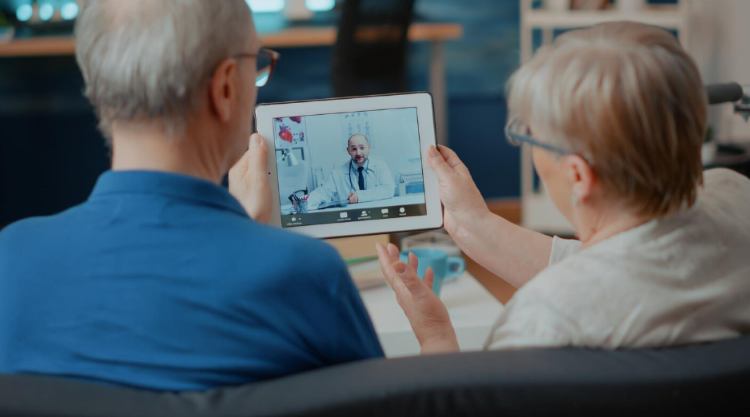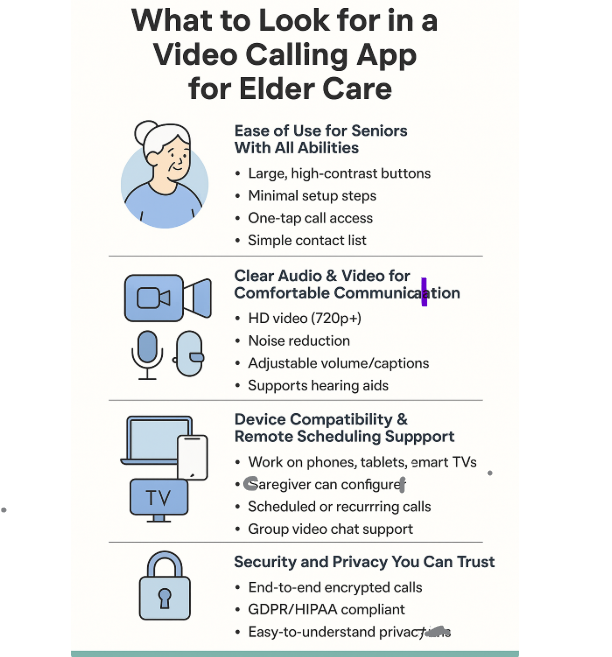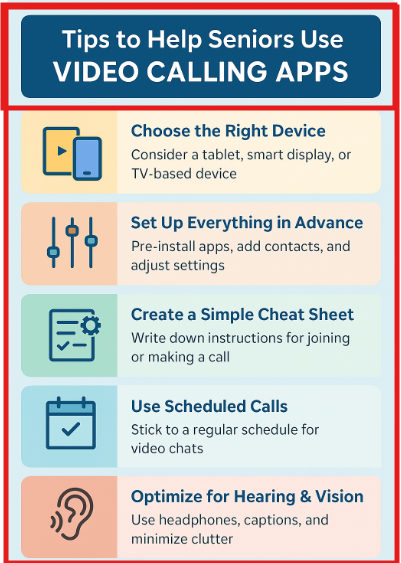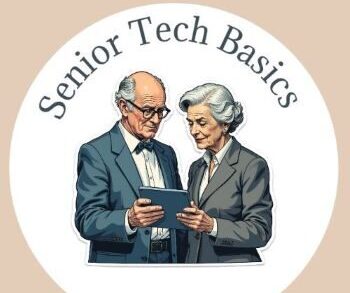
Video call apps offer a lifeline for support, companionship, and peace of mind, whether you are a family member checking in from across town or a professional caregiver managing daily care remotely.
Regular face-to-face contact, even through a screen, can help seniors reduce feelings of isolation and improve emotional well-being. At the same time, video calls enable caregivers to monitor health, coordinate care, and provide reassurance between visits.
However, some video call apps can be too complex for older adults, while others lack the features that caregivers need.
That’s why we feel compelled to share thorough content about the best video calling apps specifically suited for elder care to help elders stay in touch with loved ones or care teams.
You will find in this guide easy-to-use tools that simplify communication, reduce stress, and help seniors feel more connected, anywhere life takes them.
Why Video Calling Matters in Elder Care?
Staying socially connected becomes more complex as we age, especially for individuals who live alone or rely on caregivers. These people may need video calling as a powerful tool for their emotional well-being and quality care.
Emotional and Cognitive Benefits.
Video interactions can reduce feelings of loneliness and even help slow cognitive decline in older adults. A face-to-face chat with a familiar voice, even through a screen, typically lifts a senior’s mood, reduces anxiety, and brings a sense of normalcy and routine.
A study published by Frontiers in Public Health in 2022 found that video call use during the pandemic improved mental health and reduced loneliness in older adults.
Better Caregiver Coordination.
Not only do video calls allow caregivers to say hello, especially long-distance ones, but they also enable them to check for signs of fatigue, illness, or emotional distress that may not come across in a text or voice call.
Caregivers can also use video calls to:
- Review medications together and remind seniors of appointments.
- Monitor home safety or living conditions.
- Coordinate with family members or medical teams.
Many seniors can now use a smartphone, tablet, or smart TV to join calls with just one tap without prior knowledge, making technology feel less intimidating and more empowering.
Key Features to Look for in a Video Call App for Elder Care.
The following features can make all the difference when selecting an app for a tech-savvy elder or a newbie with limited digital experience.
Easy-to-use interface.
Older adults often have dexterity, vision, or memory challenges and need user-friendly apps featuring:
- Large, clearly labeled buttons.
- High-contrast visuals for better readability.
- Minimal steps to start or answer calls.
- Tools enabling caregivers to pre-program contacts or set up shortcuts.
Apps that feel “cluttered” or require account creation and password management can quickly discourage use, so look for simple platforms.
Audio-Visual Quality.
Poor call quality typically frustrates seniors, especially those with hearing or vision impairments and their caregivers.
A strong app should include:
- At least 720p video resolution without frequent lag.
- Noise suppression and echo cancellation for clearer audio.
- Adjustable volume and text settings.
- Optional captioning or transcription support for hard-of-hearing users.
These features make calls more enjoyable and effective.
Multi-Device Compatibility and Caregiver Scheduling Tools.
Flexibility is essential when connecting with caregivers and family members from different locations and devices.
An ideal app should:
- Work seamlessly across smartphones, tablets, laptops, and smart TVs.
- Support scheduled or recurring video calls to help establish routines.
- Provide one-tap access for seniors with limited tech confidence.
- Offer remote setup features, enabling caregivers to configure devices perfectly.
A suitable app should also allow multiple participants to join the same call for group check-ins or virtual family gatherings.
Related Content: Best Guided Meditation Apps for Stress Relief in Seniors.
Privacy and Security to Protect Sensitive Information.
Caregiving conversations typically include health, medication, or emotional concerns, making it essential to choose a platform with:
- Uses end-to-end encryption.
- Meets GDPR or HIPAA standards.
- Doesn’t store call data or personal conversations.
- Features clear, senior-friendly privacy policies.
Caregivers need to feel confident that their conversations and those they care about stay perfectly safe.

Top Video Call Apps to Stay Connected With Elder Caregivers.
The best apps should balance simplicity, functionality, and reliability to enable elders, caregivers, and loved ones to stay in contact stress-free and without confusion.
Below are the top video call apps carefully curated for elder care with unique features.
Zoom.
Zoom features a simple interface, especially on tablets, making it an excellent choice for older adults for video group calls and conferencing, which suits family check-ins or care team meetings.
Pros.
- Supports multiple participants.
- Ideal for audio and video quality calls.
- Enables screen sharing to show documents or provide medication instructions.
- Best for group caregiver coordination and family video calls.
Cons.
- Initial setup can confuse some users.
- Too many confusing features for low-tech users.
Pricing.
- Free plan for unlimited one-on-one calls and group calls up to 40 mins.
- Paid plans starting at $14.99/month.
Tip: The Free version suits most elder care.
WhatsApp.
Most seniors and caregivers use WhatsApp for texting, but this app also has an easy-to-use video call feature, which works seamlessly across smartphones and tablets.
Pros.
- One-tap video calls.
- End-to-end encryption.
- Widely available and familiar.
- Best for quick caregiver check-ins and one-on-one calls.
- Completely free, no subscription or in-app purchases.
Cons.
- Requires a smartphone.
- Doesn’t feature screen sharing or group scheduling.
Skype.
Skype has been around for years, integrating video call apps that can work with smart TVs and desktop computers, making it more accessible to seniors who prefer larger screens.
Pros.
- Cross-platform support.
- Works on smart TVs.
- Can call phone numbers as backup.
- Best for seniors using desktop or smart TV setups.
Cons.
- An interface that feels outdated.
- Unpopular among younger family members.
Pricing.
- Free for Skype-to-Skype video and voice calls.
- Paid credits to call landlines or mobile phones.
Tip: Elder care users can stick with the free version.
Google Meet.
Google Meet is a browser-based app that many use for Gmail, Google Calendar, and Google Meet; you don’t need to install it on your computer.
Pros.
- Doesn’t require installation on desktops.
- Easy to schedule in Google Calendar.
- Excellent security and privacy controls.
- Best for care teams using Google services.
Cons.
- Requires Google account setup.
- Less intuitive for first-time users.
Related Content: How to Manage Chronic Disease with Health Apps?
JubileeTV or ONSCREEN.
JubileeTV or ONSCREEN senior-specific video calling platforms feature large fonts, TV-based interfaces, and don’t require passwords.
Some models even allow caregivers to initiate calls remotely to suit seniors with cognitive challenges or dementia.
Pros.
- Built for older adults.
- Remote caregiver control.
- Works through the TV and doesn’t require a phone or tablet.
- Best for seniors with cognitive or physical limitations who prefer non-phone options.
Cons.
- May require special hardware.
- Unavailable in some regions.
Pricing.
- Requires buying a hardware device at approximately $99–$149.
- Subscription to access remote management features at $9.99 monthly.
Note: The price can vary slightly per country or promotions.
| App | Free use | Best For | Group calls | Remote Setup | Works on TV? | Subscription Needed? |
| Zoom | ✅ Free (with limits) | Family check-ins, care team meetings | ✅ Yes | ❌ No | ❌ No | Optional (Pro Plan) |
| ✅ Always Free | Quick one-on-one caregiver calls | ✅ Limited | ❌ No | ❌ No | ❌ No | |
| Skype | ✅ Free (mostly) | Seniors using desktop/TV | ✅ Yes | ❌ No | ✅ Yes (some) | Optional (for phone calls) |
| Google Meet | ✅ Free (Gmail) | Android/Gmail users | ✅ Yes | ❌ No | ❌ No | Optional (Google Workspace) |
| JubileeTV / ONSCREEN | ❌ Hardware + subscription | Seniors with dementia or mobility issues | ✅ Yes | ✅ Yes | ✅ Yes | ✅ Yes ($9.99/mo) |
Tips to Help Seniors Use Video Calling Apps Effectively.
Even the most user-friendly app can overwhelm you if you are unfamiliar with technology. Still, you can use practical tips to embrace video communication straightforwardly.
Choose a comfortable device.
Consider alternatives, such as an easy-to-hold tablet with a larger screen or a Smart Display like Echo Show if you are uncomfortable with smartphones.
Smart TV apps, such as JubileeTV, are also an excellent choice if you watch TV daily. Select what integrates smoothly into your routine whenever possible.
Adequate Setup.
It is always better to pre-install apps and create shortcuts or bookmark them for future easy use.
For example, you can set up auto-login to skip password prompts, add family or caregiver contacts with recognizable names and photos, and adjust font size or brightness for better readability.
Some devices and apps also allow remote configuration for a perfect long-distance setup, or you can ask for help if needed.
A Simple “How-To” Cheat Sheet.
You can also create a printed, laminated instruction card, which includes:
- How to start a video call.
- The button to press when answering.
- Troubleshooting tips and more.
Tip: Keep your printed “How-To” Cheat Sheet near the device for easy reference.
Use Scheduled Calls.
Repetition builds confidence, so try to:
- Schedule regular call times, like every Tuesday at 6 p.m.
- Stick with the same app and device.
- Set phone alarm reminders, calendars, or intelligent assistants.
Related Content: How Can Smartwatches Measure Blood Pressure?
Hearing, Vision, or Cognitive Challenges Optimization.
Seniors with dementia can focus on apps that offer remote control, simple buttons, and visual familiarity, such as TV interfaces.
Make minor but meaningful adjustments, including:
- Headphones to boost clarity.
- Turn on closed captions if your device supports it.
- Avoid visually distracting backgrounds.
- Speak clearly and slowly, but don’t exaggerate.
Tip: Learning new technology can intimidate you; stay patient, consistent, celebrate your progress, and don’t frustrate yourself when things go wrong.

Common Challenges and How to Overcome Them.
Some older adults still face barriers to consistent use of video call apps even with well-prepared setups.
These challenges include physical, cognitive, or emotional difficulties that caregivers need to manage with little creativity and patience.
Cognitive Impairment or Dementia.
Seniors with memory issues or cognitive decline may forget how to use the app or get overwhelmed by too many buttons.
Solutions:
- Use ultra-simplified interfaces like JubileeTV or GrandPad, explicitly designed for people with dementia.
- Stick to one device, one app, and a fixed daily call time to create a routine.
- Enable auto-answer on specific apps or devices to connect calls automatically.
A 2023 study published in the American Journal of Alzheimer’s Disease & Other Dementia found that older adults with or without dementia used video calls effectively during the COVID-19 pandemic when given the proper support, highlighting how essential simplicity and caregiver guidance can help seniors adopt technology.
Poor Internet Connection.
Unstable video or audio can quickly frustrate older users to the point of stopping using the app entirely.
Solutions:
- Switch to low-bandwidth settings in the app under “video quality”.
- Use an Ethernet connection for better stability when possible.
- Consider a mobile data plan with a 4G or 5G hotspot if you have unreliable Wi-Fi.
Tech Anxiety or Lack of Confidence.
Seniors typically fear breaking or doing something wrong, which can discourage seniors from trying video calls at all.
Solutions:
- Offer a no-pressure demonstration first.
- Encourage “practice calls” with family before using the app for caregiving.
- Provide a cheat sheet or laminated guide next to the device.
- Celebrate small wins and offer lots of praise.
Vision or Hearing Limitations.
Small screens or poor audio can frustrate older adults and even make it impossible to use video call software.
Solutions:
- Use devices with larger screens, such as tablets or smart displays.
- Turn on captions or subtitles on Zoom, Google Meet, or Skype.
- Increase font sizes, brightness, and volume.
- Try headphones or speakers that suit hearing-impaired users.
Limited Mobility or Dexterity.
Arthritis or Parkinson’s disease can make it hard to tap buttons or hold a phone steady.
Solutions:
- Use tabletop stands or voice-activated devices, such as Echo Show or Google Nest Hub.
- Choose apps with one-tap calling and larger on-screen buttons.
- Consider remote caregiver tools that allow setup and call initiation from afar.
Summary: Anticipating these common issues and offering practical workarounds enables you, as a caregiver, to turn frustrating tech into a meaningful communication tool. Adapting the technology to the user is the key.
Final Thoughts.
The right video call apps typically make communication straightforward for long-distance family members, professional caregivers, or non-tech-savvy seniors.
Choose simple-to-use tools that meet the older adult’s individual needs, without violating their privacy, to support emotional well-being and effective caregiving.
Always remember that good technology can’t replace human connection to enhance the daily life of those you care about.
Many, including caregivers, seniors, bloggers, and tech enthusiasts, also use affiliate marketing to build flexible, meaningful businesses online in their niche of choice.
You can learn how to build a website step-by-step, choose a niche, and monetize your blog or website with trusted affiliate programs, ads, and more, but online business is not a get-rich-quick scheme. Stay consistent, dedicated, and patient to build a sustainable income online over time.
